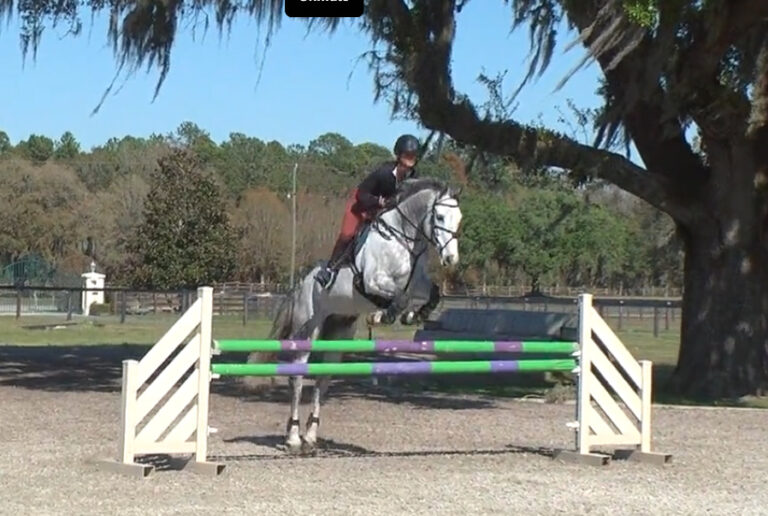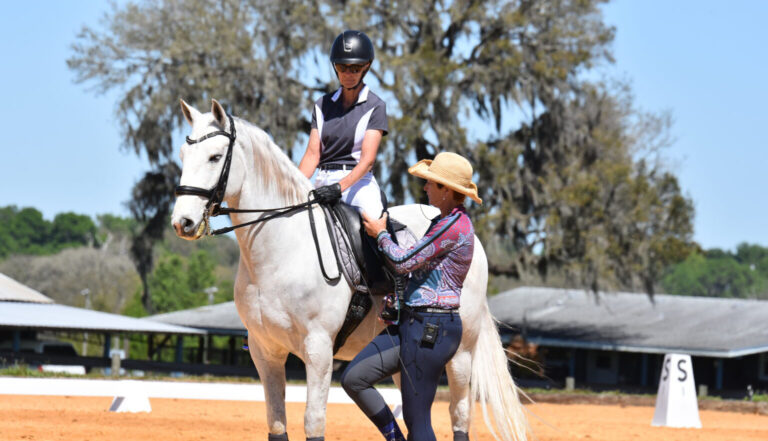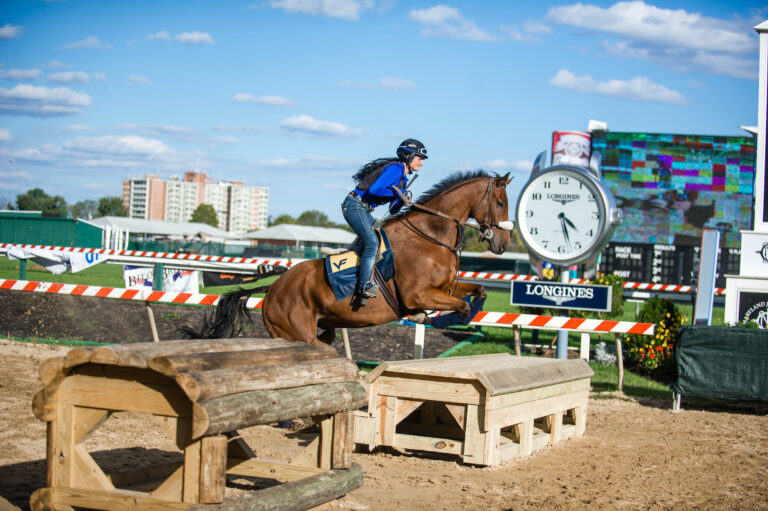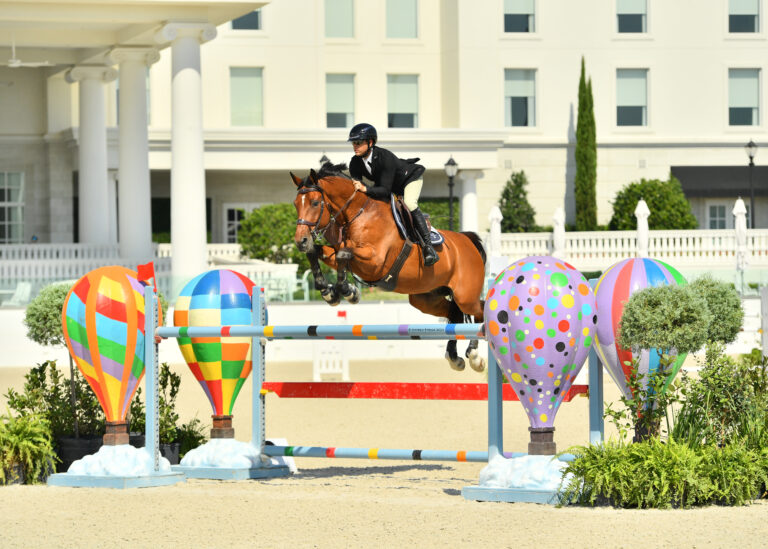Dressage clinics tend to have a reliably serious tone and atmosphere, but this year’s Adequan/USDF FEI-Level Trainers Conference combined quality instruction with ample doses of entertainment, thanks to the synergy of the four featured experts. Ashley Holzer brought bright energy and wisdom to the event, while fellow Olympian Lars Petersen contributed practical advice and clever quips that stirred the crowd. FEI***** judge Anne Gribbons revealed time-tested observations from her years of training and judging, which were peppered with parallels to greater life lessons—“Timing is everything in riding, as in life,” she mused at one point. Rockwell, also a five-star judge, with his unmistakable deep voice and polished ways, offered honest but fair observations. Retired five-star judge Lilo Fore moderated the event with her upbeat nature and a broad grin.

Lindsay Paulsen/AIMMEDIA
Held each year in late January at Mary Anne McPhail’s High Meadow Farm, in Loxahatchee, Florida, the conference is an entry point into a unique pipeline of dressage education: Great riders receive instruction and feedback from the country’s leaders in dressage, and trainers from around the country study the sessions to soak up the knowledge to share it with students back home.
For auditors, it was hugely beneficial to hear each individual expert’s perspective on a particular highlight or challenge in the training. However, credit must be given to the riders who had to take in an enormous amount of information and instruction from four different sources in front of hundreds of auditors—in a relatively short period of time.
As the conference began, Gribbons reminded auditors that the point of the clinic was to study the training challenges that each horse and rider face and to work through them as a team for the benefit of everyone’s learning. Each expert in this star-studded lineup brought a different approach to training challenges—but the same themes of classical dressage rang true throughout the event. Following are some of the most useful tips we gathered throughout the two-day clinic that are applicable to dressage training at every level.
1. Utilize correct, balanced stretching to promote a softer topline.
Meagan Davis and Leopold of Shakespeare kicked off the event, and the horse showed nice rhythm with good cadence and expression. In the warm-up, Gribbons advised Davis to let her horse’s neck stretch down and forward, since the horse had a tendency to curl. “You want to supple the back so that it is nice to sit on and you don’t tighten him up too early,” she said.
Later, Petersen encouraged Emily Donaldson to stretch her horse, Audi, a little deeper to loosen the base of his neck, but he also wanted her to consider the horse’s balance. “It’s important that when we ride deep with stretching, it’s not just going around with the head down. Keep the balance in mind.”
During Lauren Sprieser’s ride aboard Guernsey Elvis, who showed nice gaits and great proficiency at the Prix St. Georges level, Rockwell pointed out the delicate nature of the horse and how easily he flexed in the poll. He said that he would like the horse’s neck to be more developed, and that development isn’t possible if the horse flexes too much in the poll. “An outward stretch is more related to the back than poll flexion,” he said. “For a horse who wants to curl up, you have to ask him to go somewhere and then let him go. If the poll starts to disappear, you know you have to let it go a little more out. If a horse is at the vertical and your hands get a little high, he will probably [curl] over more. Think about ‘oozing’ the reins slowly forward to allow him a little more stretch in the neck muscles.” During Sprieser’s session, Petersen chimed in with a helpful tip to think differently about the reins: “Think of the reins as something to keep the nose out, not hold back on. If you feel like you have to hold back, that’s when you half-halt and let go again.”
2. Break up tension with transitions and riding in different shapes.
During Donaldson’s ride with Audi, Holzer honed in on tension in Audi’s back. She advised Donaldson to ride several transitions, such as going from trot to canter to loosen his back, as well as going forward and back within the canter itself. “Think about riding your transition with your seat and not as much with your hands. Start the transition with your seat.” Holzer also encouraged Donaldson to use the space within the arena wisely, so she wasn’t always just riding around the track and then across the diagonal. Holzer likes to ask her riders to warm up coming down centerlines and think about adjustability as they do so, imagining the horse’s topline as a rubber band or an accordion that can compress and expand. When Audi had looky moments, Holzer told Donaldson to bring him back to a circle and spiral in and out.

Lindsay Paulsen/AIMMEDIA
3. Encourage your horse to carry you.
“You’re not supposed to carry the horse. He’s supposed to carry you,” Gribbons reminded Davis. To encourage your horse to take weight behind, try this:
• Walk on the rail (in either direction).
• Ride shoulder-fore.
• Ride walk–canter and canter–walk transitions. Do not allow the horse to trot in the transitions.
• Reverse and ride it in the opposite direction.
This exercise reminds the horse to sit on his hind leg and helps the rider tell the horse, “Sit here, now!” As you try this, remember that the horse’s front feet should come down like snowflakes—they shouldn’t jam into the ground. The use of shoulder-fore in this exercise helps the rider have more influence over the horse’s body. “You are stronger [and have more influence] when you put him in a slight sideways feeling,” Gribbons said. “This super boring exercise works. It makes them stronger in all the canter work. It makes them sit back and go, ‘OK. Where do you want me?’”
The idea of self-carriage was a strong theme through Davis’s ride as the panel of experts aimed to help her with flying changes. “I think that’s a big thing for the changes: The horse is not carrying himself. We don’t want to just ride the horse’s canter. We want to own the stride,” Petersen said.
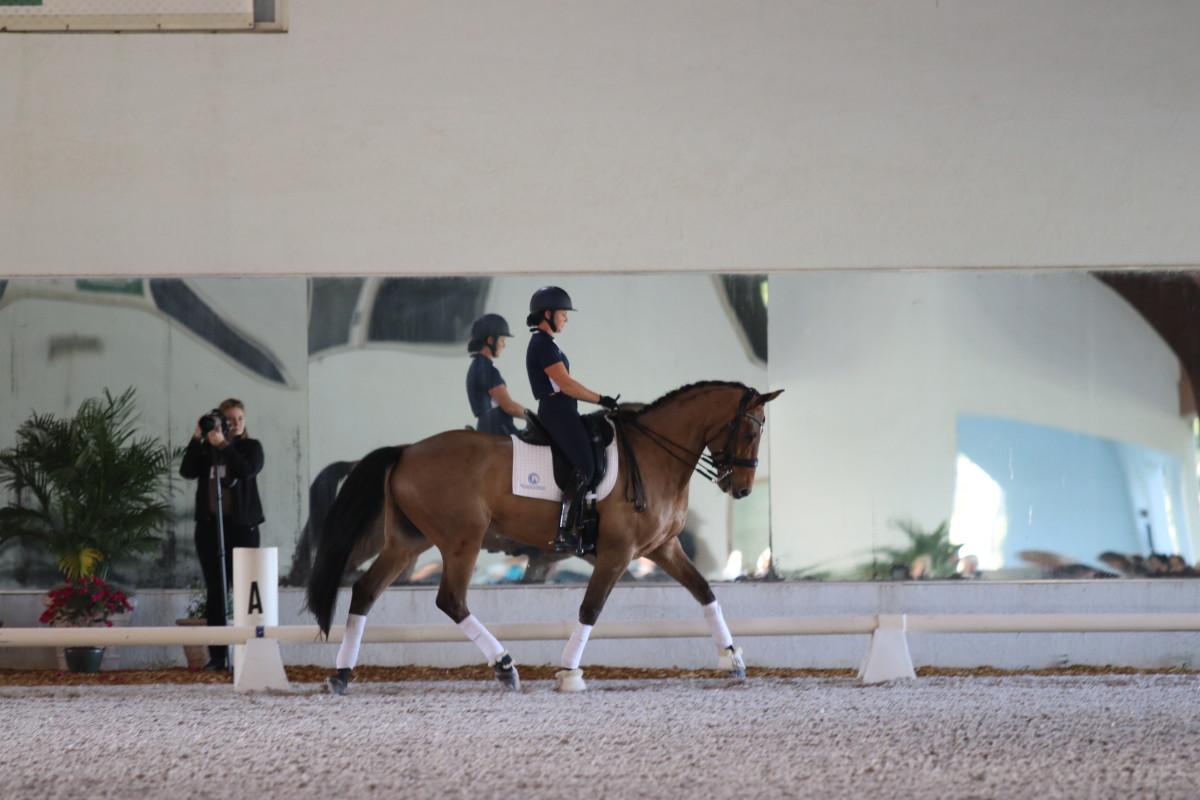
Lindsay Paulsen/AIMMEDIA
4. Repetition is not always the answer.
As the experts worked together to improve the changes, Holzer reminded Davis not to drill the horse. “Remember that if you keep going and going and he fatigues out, it’s not going to get any better.” Holzer said that if the horse falls out of the canter, going back to the walk and riding walk pirouettes is more productive. Later, Rockwell pointed out that in the effort to improve the flying changes, consider the root of the problem and the preparation for the changes. He noted that revisiting and improving the walk-canter transitions was important. “You can’t just fix the flying changes by ‘making’ flying changes,” he said. To Rockwell’s point, Gribbons added: “We all know that the changes are rarely better than the quality of the canter.”
5. Use bend to ride smarter, not harder.
“You have to be clever with your riding. You’re never going to outpower him,” Gribbons told Donaldson during one of Audi’s more explosive moments. “It’s always easier to be in control of the action when you have the horse on a slightly bent line,” she said. Petersen explained that bend is also a critical component of straightness: “At the end of the day, it’s the bending work that makes your horse straight. If you ride straight to ride straight, you end up with a stiff horse.”
6. Use the leg-yield wisely.
Petersen explained that he likes to use canter leg-yields when the horse is a little stiff in the topline. Before you work on leg-yields in canter, ride a little forward and back. Then work on leg-yielding in and out—from the centerline to the rail and back—and incorporate some counter bending. According to Petersen, this helps to supple the horse. Holzer says that a correctly ridden leg-yield can be tremendously helpful for a horse who gets strong. “Bending him makes him softer,” she explained. “Bend should decrease the tension along the topline. When he gets really straight, it’s easier for him to lock his back.”
While the leg-yield can be useful, be mindful about how you perform it. Holzer urged riders to make sure that within the leg-yield, the horse truly yields to the leg, rather than the hand. “Ride the leg-yielding exercise, not a hand-yielding exercise. … I see a lot of riders trying to leg-yield, but it’s unbalanced hand-yielding.”
Rockwell explained that leg-yielding is an easy exercise for the horse if it is ridden correctly. “It can supple the horse and improve the balance and the freedom of the shoulders. It also teaches the horse to move away from the inside leg onto the outside rein. Overbending with steep angles can be detrimental to the balance, the quality of the gait and the connection.”
As Holzer worked with Hanna Benne and Rigadoon, she cautioned Benne not to ride steep leg-yields that might take away from the horse’s ability to balance. “If you have a horse who is a little backed off the bridle, ride straight lines with gradual leg-yielding,” she said. “Find the balance that enables him to find confidence in your leg and hand. Too much bend might prevent him from going to the bridle in the beginning,” she explained.

Lindsay Paulsen/AIMMEDIA
7. Speed is not the answer.
Holzer told Benne not to rush the horse off of his feet in an effort to encourage him to go to the bridle. “Remember that having the horse in front of you doesn’t have anything to do with speed,” she said. “Think more about his balance than his speed. Sometimes horses won’t go to the bridle because they aren’t balanced.”
During Sprieser’s ride on Guernsey Elvis, Holzer helped Sprieser ride a small trot to prevent the horse’s hind leg from overpowering his front leg and putting him on the forehand. “Ride a piddly trot,” she said, explaining that people misinterpret speed. “Part of my training is that I teach the horse to think about power without speed. … Show him different positions with power.”
8. Don’t fixate on a fancy trot.
Guernsey Elvis had plenty to offer in terms of expressive gaits, but Holzer reminded Sprieser that the fancy trot is only a piece of the puzzle. “Think about the fancy trot as the cardio part of the workout and then go back to the small trot for the balance and the harmony.” Holzer emphasized fine tuning. “You need that fine, fine tuning that is so tedious. It’s not just going around straight. It’s bending, straightening, bending, straightening. It’s all that little minutiae that is going to make him a huge talent. Don’t focus so much on the fancy trot—we only have to do two minutes of fancy trot in the Grand Prix.”
9. Train your eyes.
“I think all riders need to train their eyes,” Rockwell said while working with Donaldson. “Train yourself to look up ahead. When you start to make the collected work, especially the half-passes, you can’t take your eye off the destination. Your horse has to make the same amount forward and sideways. You can’t do that just by feel. You have to look at where your horse is going.”
In the pirouette work, Rockwell encouraged Donaldson to point her chin in the direction she wanted to go—for example, if the pirouette circle was analogous to the face of a watch, she should point her chin toward one o’clock, two o’clock and so on. Gribbons explained a similar idea: “Your eyes have to go where you want your horse to go, don’t look down at his withers and hope for the best.” As Donaldson began to use her eyes better, Gribbons pointed out the difference in the horse. “As soon as you looked where you were going, he also knew where you were going. As soon as you started to think where you were taking him, he began following your eyes.” Holzer echoed similar thoughts during Benne’s session: “Look exactly where you are going. Make informed decisions about where you are going.”
10. Teach your horse how to use all of the different parts of his body and be in control of it.
Rigadoon showed great talent and ability to take weight behind and was overeager, which presented a challenge of its own. “This horse is super talented. He tries too hard,” Holzer said. “You have to teach him a way to come off of his hind legs … He doesn’t understand he can actually lower his neck to get weight off of his hind end. I know it sounds crazy because in dressage training, we are mostly paying attention to the hind end.” Holzer wanted Benne to help Rigadoon lengthen his neck to unload his hind end. “You have to teach the horses to use all the different parts of their body so that you have the adjustability. For example, if I’m in a test, it looks like I’m in one frame the whole time—but I’m not. I’m not saying dump them on the forehand but let them figure out how to use their bodies so that they don’t overtax their bodies. You should be the one determining how much weight comes onto his hind legs, not him.”
11. Develop your own core strength.
Emma Asher’s Elegance N was clearly talented, but also quite looky—a quality that hinted toward his Jazz bloodlines. Holzer pointed out that in her experience with Jazz offspring, they like to be able to feel the rider’s hand as extra security. “If you give your hand, they can get spooky.” She explained, however, that riding more off the hands can contribute to an issue in the horse’s mouth. “Get stronger with your seat so you can come off your hands,” she said. As Asher was able to ride him more with her seat and less with her hands, the whole pictured improved. “The more you get him on the hind legs, on your seat, the more he closes the mouth,” Petersen added.
Toward the end of the day, the audience was treated to a session with Olympian Kasey Perry-Glass, aboard Mistico TM. Perry-Glass was a great example of how a rider with a small body can be hugely effective, given that she has a strong core. Her exemplary position and effectiveness of her aids were reflected in her horse’s relaxed and consistent way of going in the warm-up.
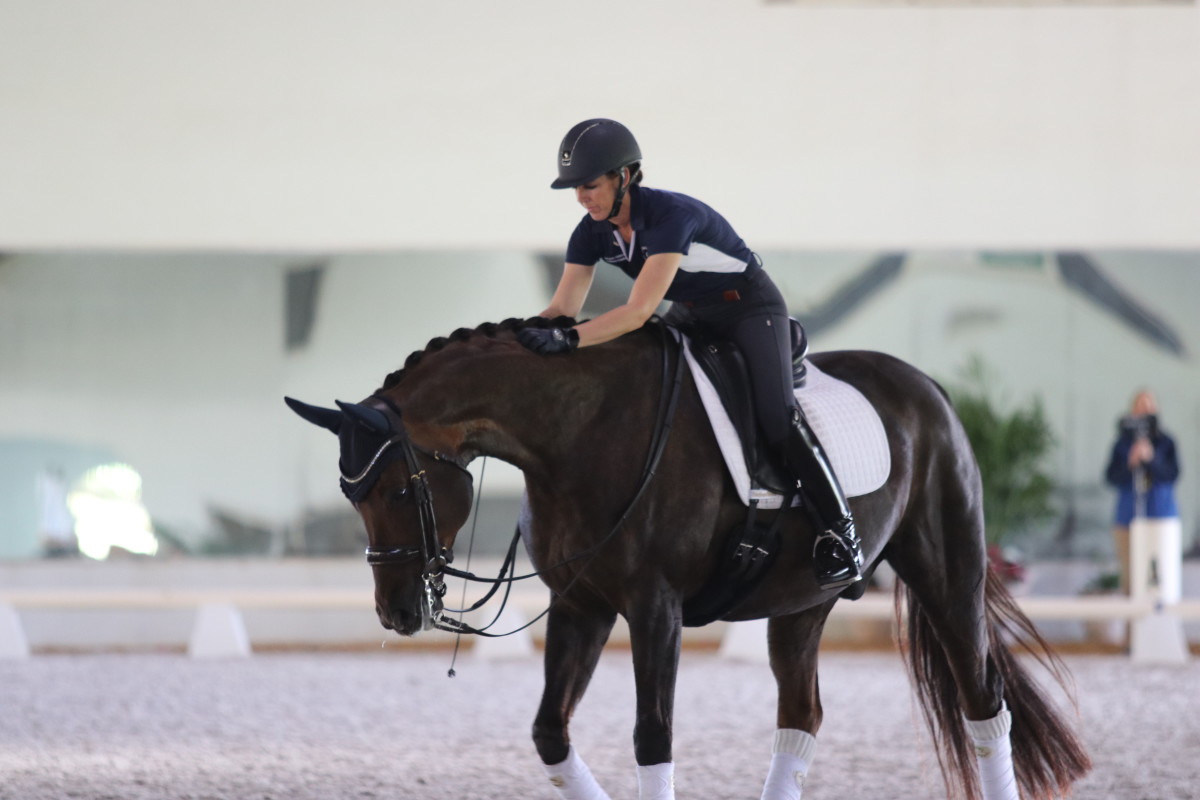
Lindsay Paulsen/AIMMEDIA
12. Don’t neglect the walk.
Perry-Glass’s horse presented a beautiful picture, but had a tendency to get tense in the walk. “A lot of people don’t spend a lot of time at the walk, even though it’s worth a lot of points in the show ring,” Holzer said. “I would caution a lot of you as trainers to help your students understand a good, clean walk, ways to supple the walk, etc. It’s actually probably the hardest gait there is.”
13. Break down movements to make your horse’s job easy.
“If you have trouble with an exercise, come to the lowest common denominator of the exercise. For example, if it’s a pirouette, it’s strength of the hind leg, bend, obedience,” Holzer explained while she and Perry-Glass worked to improve Mistico’s pirouettes. “For the pirouette, your canter has to be incredibly small and jumping. Your pirouette is completely controlled by the size of your canter,” she explained. As Mistico struggled a bit with the pirouettes, Holzer determined that it wasn’t due to misbehavior. “Horses will sometimes do things that are naughty and sometimes they will do things because they give you information. He’s saying ‘This is hard for me.’ He isn’t being naughty. Learn to trick him. If you make it super easy for the horse, they’ll give you more.” Holzer had Perry-Glass put this idea into action by riding only a quarter of a pirouette instead of a full pirouette. “Instead of him thinking ‘This is hard, this is hard, this is hard,’ make him think this is easy. Whenever you think the defense is coming out, ride back out [of the pirouette].”
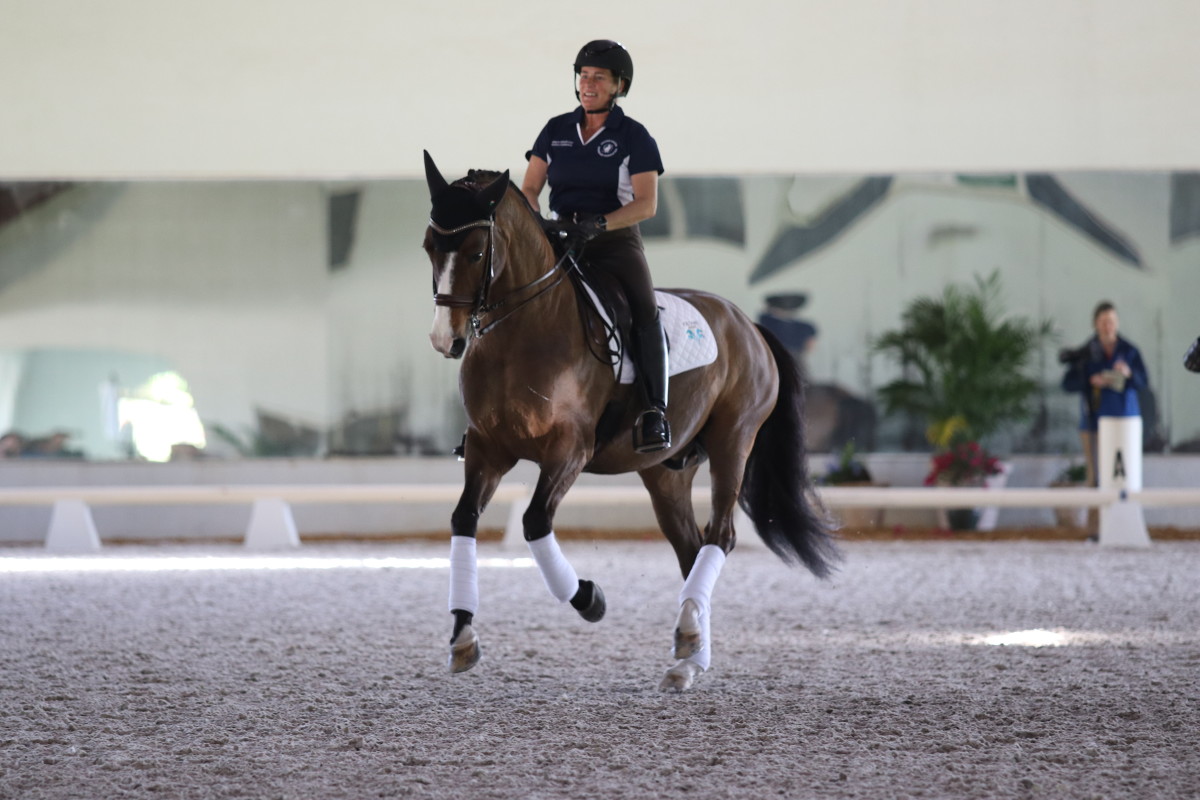
Lindsay Paulsen/AIMMEDIA
14. Test the limits, face struggles and learn from mistakes.
“The focus on relaxation is crucial—it’s where you have to start and finish, but if you are working on a problem, to change anything, it requires effort. Don’t throw your hands up if there’s tension,” Rockwell explained to Davis as they worked to encourage the horse to engage his hind end. Holzer touched on this theme again during Lauren Sprieser’s session aboard Helio on Day 2 of the clinic. “Don’t think it’s all wrong because you’ve added tension. When there’s training, there is tension.”
The concept reemerged during Olympian Michelle Gibson’s ride on Barland I.M.: “If we don’t go to the level of where they struggle, we don’t know where the limit is,” Holzer said. “It’s not wrong to go to the place of almost failure. What is wrong is to not identify when they are struggling and need a break.”
15. Refine your ability to read situations—it’s your responsibility.
“Training is all about reading the horse,” Petersen explained during Donaldson’s work with Audi. Gribbons added: “The horse will tell you how it’s going.” Later in the event, Holzer explained that the concept doesn’t just apply to training horses: “It’s important to read our horses. And it’s different for every horse. And that’s your responsibility as a trainer. And as a trainer for people, too.” According to Holzer, being flexible and making adjustments in the training is also important. She gets on a horse with a plan, but then modifies it to suit the horse. “That’s part of being a good trainer: Recalculating.”
Dressage Today OnDemand
Want to learn more from the experts, horses and riders who were spotlighted at this year’s Trainers Conference? You can watch videos of the sessions on Dressage Today OnDemand! Visit ondemand.dressagetoday.com to learn more and subscribe for a free 10-day trial.
This article originally appeared in the Summer 2020 issue.





